WHATEVER THE WEATHER: In Praise of Temperature Blankets
Filing my tax return just before a significant birthday last month, Benjamin Franklin’s dictum that “nothing is certain in life except death and taxes” hit home. Seeking uncertainties as an antidote, I turned to thinking about English weather. What could be more uncertain? Perhaps that’s why we talk about it so much. According to social anthropologist Kate Fox, author of Watching the English, every hour of the day at least a third of the population of England remarks on the weather.
I’m one of them. The weather app on my phone is one of the first things I look at each morning. I’ve usually forgotten the details by the next day, but this year, a new craft project is helping me produce a lasting record of one aspect of those addictive meteorological reports: the temperature blanket.
I first heard about temperature blankets during lockdown, but I’d already begun a pandemic knitting project—a throw featuring the colours of the Scottish Highlands that we missed visiting during the Covid years.
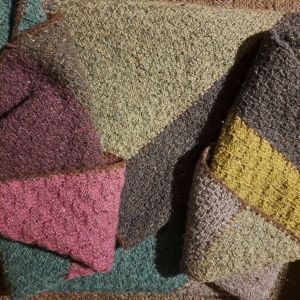 My lockdown project – a blanket in the colours of the Scottish Highlands
My lockdown project – a blanket in the colours of the Scottish Highlands
But at the start of January, I decided that 2025 would be my year of the temperature blanket.
What is a temperature blanket exactly?
At the start of the year, you pick yarn in a colour palette with particular shades representing different thermometer readings. To keep it simple, allocate one colour to every few degrees rather than to every number. (For my blanket, I’ve chosen one colour to five degrees centigrade.)
Knitting a couple of rows to reflect each day’s temperature, it’s fun to watch the stripes build up.
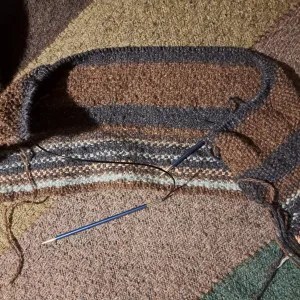 The wide stripes show how consistent the weather had been in February, while the narrow stripes at the bottom indicate a more varied January. I’m knitting it in linen stitch, which creates a woven effect. (See header picture for close-up.)
The wide stripes show how consistent the weather had been in February, while the narrow stripes at the bottom indicate a more varied January. I’m knitting it in linen stitch, which creates a woven effect. (See header picture for close-up.)For a smaller-scale challenge, apply the same thinking to a jumper or a scarf. A scientifically-minded friend is knitting a reversible scarf with minimum daily temperature on one side and maximum on the other.
If knitting isn’t your thing, you might crochet a row or a new granny square each day, or sew a colour-coded patchwork quilt.
Not into needlework? Apply the same principles to other crafts such as weaving, stringing beads, or abstract painting. You could even just colour in the squares for each day on a calendar or year planner.
Customise your project to suit your personal tastes. You don’t have to choose the obvious shades to represent temperatures—white for freezing, red for scorching hot, etc.
Although I’m a meteorologist’s daughter, my approach is more aesthetic than scientific.
I picked yarn to match my Scottish Highlands blanket, also the colour scheme for my front room.
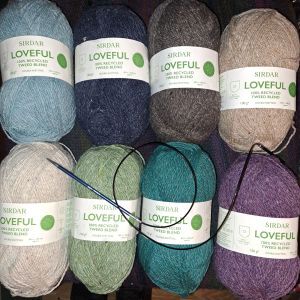 My choice of colour template in temperature order, from below freezing top left, to a warm purple for summer bottom right
My choice of colour template in temperature order, from below freezing top left, to a warm purple for summer bottom rightAre you wishing I’d told you about this new year challenge earlier so that you could start your project from January 1st? Make up for lost time by visiting the website www.temperature-blanket.com, which will tell you the historic temperature anywhere in the world, including Tetbury.
Looking forward to knitting my two rows in the appropriate colour each evening makes me talk less about the weather during the rest of the day.
The downside? I spend an alarming amount of time telling people all about my temperature blanket instead.
(This post first appeared in the Tetbury Advertiser’s February 2025 edition.)
IN OTHER NEWS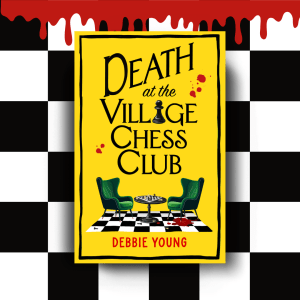 Coming on 3rd March!
Coming on 3rd March!With just over two weeks to go until the launch of Death at the Village Chess Club, I’m thrilled that the first in this new series, Death at the Old Curiosity Shop, is doing really well, thanks to smart marketing by my publisher Boldwood Books. For the last few weeks, it’s been consistently in the top 100 bestsellers of the UK Kindle chart, and as high as #2 in the Cosy Mystery chart. I’m hoping lots of the readers enjoying the first book will order this sequel!
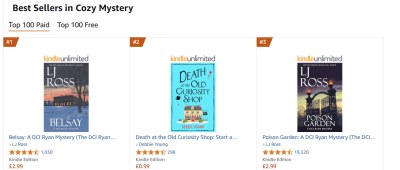
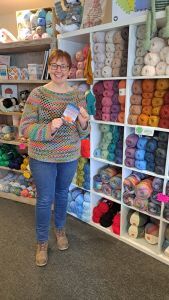 So pleased to have my little knitting mystery stocked in a knitting shop!
So pleased to have my little knitting mystery stocked in a knitting shop!Knitting features in Death at the Village Chess Club and will also be a focal point in the sequel – but this isn’t the first time I’ve written about it in my fiction. I’m pleased to announce that The Wool Cellar in Chipping Sodbury will shortly be stocking my novelette The Natter of Knitters, which was published back in 2020. It made Jo, the proprietor, laugh so much that she’s asked permission to print out quotes about knitting from it to pin up around her shop. What fun!
After getting a bit snowed under with live events last year, I’m rationing myself to just one a month in 2025, and a week today, Saturday 22nd February at 2pm, will be my February event – a joint talk with fellow crime writer Anna Britton at Thornbury Library, Thornbury, near Bristol, BS35 2AA. Anna and I write very different sub-genres of crime fiction – hers is police procedural, and mine is cosy mystery. We’ll have fun talking about the similarities and differences in our work, and about our writing lives.
Click here to find out more about it and to book your ticket via Eventbrite. We’d love to see you there!
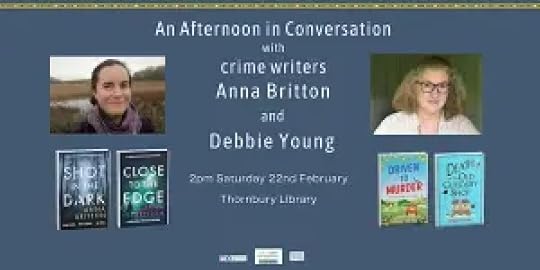
 No prizes for guessing what I’m reading this week: Anna Britton’s first novel Shot in the Dark. It’s an assured debut with an interesting structure, featuring a two-woman team of two female detectives. The strapline on its cover – “Three bullets – five suspects – no alibis” – is very intriguing, and I’m gripped!
No prizes for guessing what I’m reading this week: Anna Britton’s first novel Shot in the Dark. It’s an assured debut with an interesting structure, featuring a two-woman team of two female detectives. The strapline on its cover – “Three bullets – five suspects – no alibis” – is very intriguing, and I’m gripped!
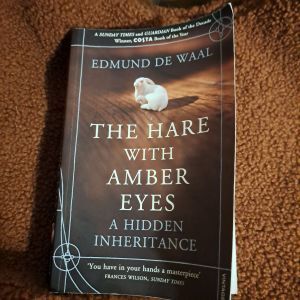 Rather a different read from the book I’ve just finished reading: ceramicist Edmund de Waal’s Hare with Amber Eyes, a remarkable multi-generational family history focused around his ancestor’s collection of 264 netsuke, which migrate from Japan to Paris to Vienna to Japan in the hands of those who inherit them. I chose this book as I wanted to learn more about netsuke – intricately carved Japanese toggles used to attach purses to kimono sashes. Why? Because they’ll be featuring in the third book in the Cotswold Curiosity Shop series, my current work-in-progress. More news on that soon!
Rather a different read from the book I’ve just finished reading: ceramicist Edmund de Waal’s Hare with Amber Eyes, a remarkable multi-generational family history focused around his ancestor’s collection of 264 netsuke, which migrate from Japan to Paris to Vienna to Japan in the hands of those who inherit them. I chose this book as I wanted to learn more about netsuke – intricately carved Japanese toggles used to attach purses to kimono sashes. Why? Because they’ll be featuring in the third book in the Cotswold Curiosity Shop series, my current work-in-progress. More news on that soon!



